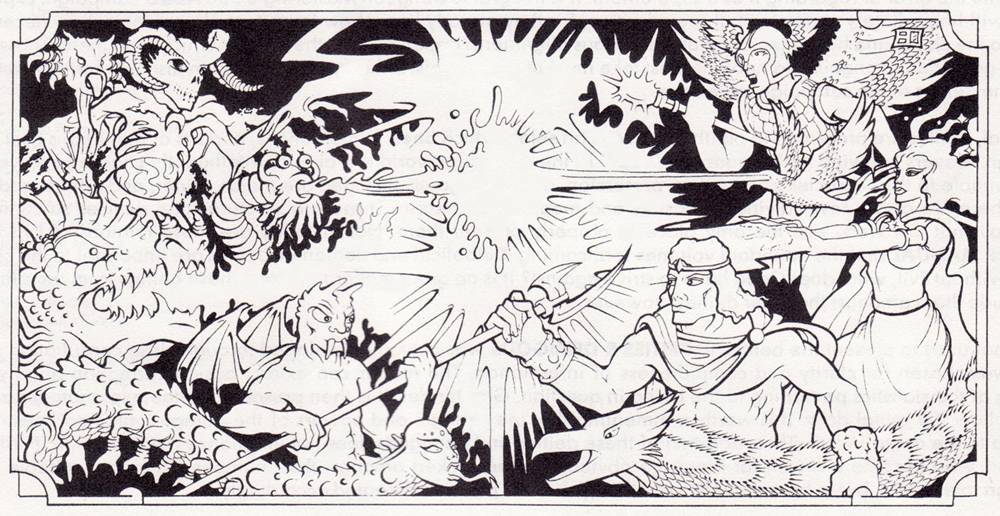5 hours ago
Sunday, November 26, 2017
The Meaning of Good & Evil (Alignments)
I don't use alignment much in my games admittedly, but I do like the idea of alignment as indication of at best only loosely morality-related cosmic teams or alliances. Even with the approach their are times where you might need to articulate in some way what an alignment means on a closer to human level. What follows is a way of looking at it in those situation.
The idea (not original to me) is that Law vs. Chaos is the primary conflict underpinning the multiverse. This works well with both the Appendix N source material and earliest iterations of D&D. The Good vs. Evil can only be understood in relation to that primary axis. This secondary parameter gives an indication of the zealotry and methods employed to combat the opposing force. Those on the Good side of things believe that the opposing force can be moderated, ameliorated, or dealt with with less violent means. Those on the evil side of things believe that the opposing force cannot be tolerated or reasoned with, only destroyed.
So Lawful Good and Lawful Evil agree that Chaos is a threat, but Lawful Good has a more moderate maybe even "hate the sin, love the sinner" view, whereas Lawful Evil feels all chaos must die by any means necessary. Chaotic Good believes that Law is a wrongheaded constraint on freedom, but hearts and minds can be changed without violence in most cases (violence being coercion, after all), whereas Chaotic Evil wants what it wants so intently it's willing to see everything burn.
This way of looking at things has the advantage of showing a way around the rigid, asshole paladin, and also explaining the Dwarf/Elf tension despite the fact they are both Good, and also suggests demons and Devils would never team-up. Neutral Goods become "let's all get along" maybe and Neutral Evil is perhaps "a pox on all your houses!" True Neutral remains about balance.
Subscribe to:
Post Comments (Atom)










4 comments:
That is a reasonable approach. I coul
Personally, I use method of just having Lawful, Chaotic, and Neutral. I use the definition of alignment meaning an alliance or agreement. Mortals only Lawful or Chaotic alignments by active means, such as making a pact. Mot other people, whether they are a cold-blooded murder or a charitable healer, are just neutral.
Spells that detect alignment or magic items that depend on them work based on the relationship the individual has with otherworldy forces.
One advantage is that you can easily add or remove factions from this alignment system. It isn't attempting to be some kind of personality test. It's just a list of the cosmic forces that exist in your setting that players can engage with.
Broadly speaking, there are two kinds of alignment systems: Cosmic Forces™ and Clash of Civilizations™.
Alignment in AD&D takes after Moorcock's Elric: alignment is cosmic, only the gods and other mighty supernatural entities are truly of Law or of Chaos, and mortals pick a side in order to survive a conflict they can't really grasp.
Alignment in D&D or Chainmail is more like the clash of civilizations, which you see in Tolkien (Free Peoples vs. Shadow/Enemy) or Star Wars (light side vs. dark side), but the better example in a gaming context would be Anderson's Three Hearts and Three Lions, where Law is the realm of men and civilization and Chaos is old world of magic and monsters and fairies.
I prefer the latter, to the point where in my games I totally divest alignment from morality or behavior or even player choice and just make it a quality inherent in different beings: humans without magic are Lawful, demi-humans and magic-users are Neutral, and most monsters are Chaotic, just by definition, and that's all there is to it. Makes things nice and simple.
I don't really see much difference necessarily with the Anderson approach and the Moorcockian one, except the parameters of the story they're in. And the fact that humans in Anderson don't get to choose their alignment.
I like this take. I've been running OD&D/clones when I run things lately, so I've been using just L/N/C. But one thing I've stressed (I actually just incorporated it into my house rule sheet as a clarification) is that in my setting L/C have absolutely nothing to do with G/E, and that alignments are not codes of behavior (in a traditional sense): "any behavior that furthers the cause (of cosmic law/chaos) is acceptable." So if being kind and virtuous furthers the cause of chaos somehow, that's great. If burning an orc village furthers the cause of law somehow, that's okay too (maybe not from a moral standpoint necessarily, but from an alignment one).
Post a Comment